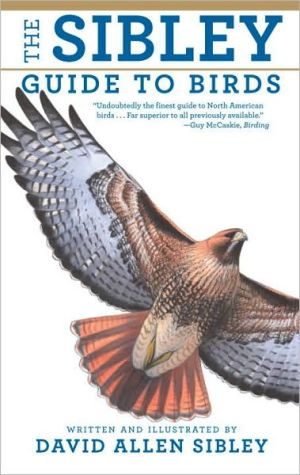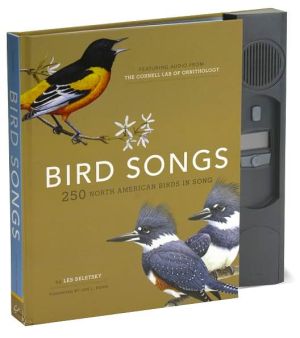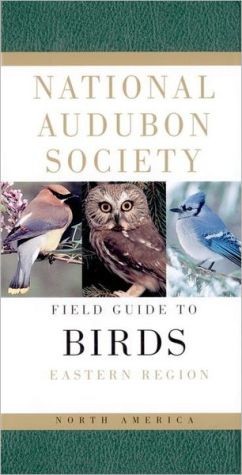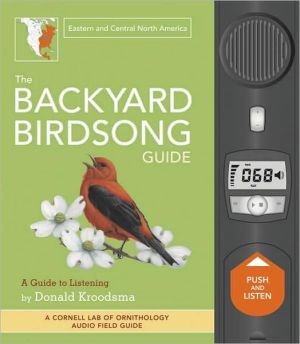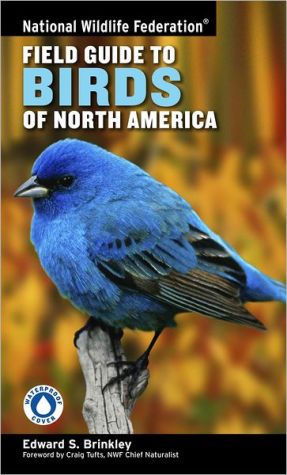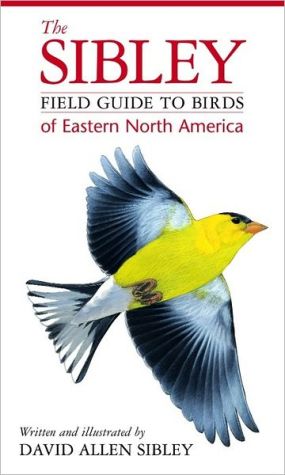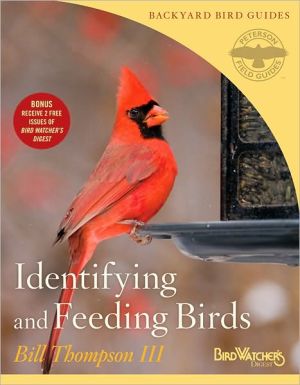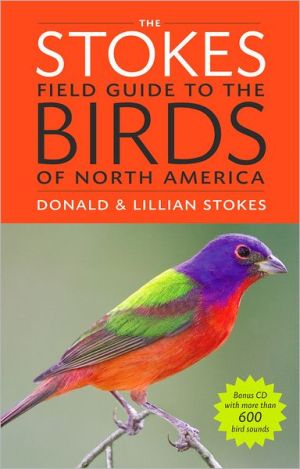National Audubon Society: The Sibley Guide to Birds
David Allen Sibley, America's most gifted contemporary painter of birds, is the author and illustrator of this comprehensive guide. His beautifully detailed illustrations—more than 6,600 in all—and descriptions of 810 species and 350 regional populations will enrich every birder's experience.\ The Sibley Guide's innovative design makes it entirely user friendly. The illustrations are arranged to facilitate comparison, yet still capture the unique character of each species.\ The Sibley Guide...
Search in google:
David Allen Sibley, America's most gifted contemporary painter of birds, is the author and illustrator of this comprehensive guide. His beautifully detailed illustrations—more than 6,600 in all—and descriptions of 810 species and 350 regional populations will enrich every birder's experience.The Sibley Guide's innovative design makes it entirely user friendly. The illustrations are arranged to facilitate comparison, yet still capture the unique character of each species.The Sibley Guide to Birds provides a wealth of new information:—Captioned illustrations show many previously unpublished field marks and revisions of known marks—Nearly every species is shown in flight—Measurements include length, wingspan, and weight for every species—Subspecies and geographic varients are covered thoroughly—Complete voice descriptions are included for every species—Maps show the complete distribution of every species: summer and winter ranges, migration routes, and rare occurrencesBoth novice and experienced birders will appreciate these and other innovative features:—An introductory page for each family or group of related families makes comparisons simple—Clear and concise labels with pointers identify field marks directly—Birds are illustrated in similar poses to make comparisons between species quick and easy—Illustrations emphasize the way birds look in the fieldWith The Sibley Guide to Birds, the National Audubon Society makes the art and expertise of David Sibley available to the world in a comprehensive, handsome, easy-to-use volume that will be the indispensable identification guide every birder must own. The New York Times - E. Vernon Laux A must-have guide for anyone interested in birds.
Acknowledgments Introduction Classification of Birds Learning to Identify Birds Variation in Appearance Learning Songs and Calls Finding Rare Birds Ethics Extinct Species Bird Topography Parts of a Passerine Head Feathers Body Feathers Wing Feathers Parts of a Shorebird Parts of a Duck Parts of a Gull Molt and Plumage North American Birds Species Accounts Loons Grebes Albatrosses, Petrels, and Shearwaters Storm-Petrels Pelecaniformes Anhinga, Boobies, Cormorants, Frigatebirds, Gannets, Pelicans, Tropicbirds Cormorants and Anthinga Identification of Sulids Wading Birds Bitterns, Egrets, Flamingos, Herons, Ibises, Spoonbills, Storks Identification of White Herons Identification of Dark Ibises Swans, Geese, and Ducks Identification of Swans Geese Head and Bill Shapes Domestic Waterfowl Exotic Waterfowl Identification of Scaup Identification of Eiders Diving Motions Identification of Scoters Identification of Goldeneyes Diurnal Raptors Eagles, Falcons, Hawks, Vultures Harrier Flight Shapes Raptor Hunting Techniques Identification of Accipiters Identification of Buteos Identification of Falcons Upland Game Birds Chachalacas, Grouse, Partridges, Pheasants, Prairie-Chickens, Ptarmigan, Quail, Turkeys Exotic Game Birds Gruiformes Coots, Cranes, Limpkin, Moorhens, Rails Habits of Rails Shorebirds Avocets, Curlews, Dowitchers, Godwits, Jacanas, Lapwings, Oystercatchers, Phalaropes, Plovers, Ruff, Sandpipers, Snipe, Stilts, Turnstones, Willet, Woodcocks, Yellowlegs Rare Shorebirds Aging and Identification of Shorebirds Identification of Peeps Aerial Displays of Snipe and Woodcock Identification of Phalaropes Jaegers and Skuas Jaeger Bill Shapes Gulls, Terns, and Skimmers Hybrid Gulls Identification of Gulls Alcids Auklets, Dovekie, Guillemots, Murrelets, Murres, Puffins Identification of Murres Pigeons and Doves Parrots and Their Allies Cuckoos and Their Allies Anis, Cuckoos, Roadrunners Owls Goatsuckers and Swifts Hummingbirds Identification of Hummingbirds Trogons Kingfishers Woodpeckers Drumming Sounds Tyrant Flycatchers Flycatchers, Kingbirds, Pewees, Phoebes, Wood-Pewees Shrikes and Vireos Jays, Crows, and Their Allies Crows, Jays, Magpies, Ravens, Scrub-Jays Larks Open-Ground Birds Swallows Molt in Swallows Chickadees and Their Allies Bushtit, Chickadees, Titmice, Verdin Drab Gray Birds of the Arid Southwest Nuthatches and Creepers Wrens Scold Notes Sedge Wren and Grass Sparrows Old World Warblers, Thrushes, and Their Allies Bluebirds, Dippers, Gnatcatchers, Kinglets, Robins, Thrushes, Warblers, Wrentit Identification of Gnatcatchers Typical Thrushes Robinlike Songs Mimids Catbirds, Mockingbirds, Thrashers Starlings and Mynas Wagtails and Pipits Silky-Flycatchers and Bulbuls Waxwings Wood-Warblers Parulas, Redstarts, Warblers, Waterthrushes Blue-winged x Golden-winged Hybrids Warbler Plumages Identification of Fall Warblers Identifying Songs Aberrant Passerines Tanagers, Cardinals, and Their Allies Bananaquit, Cardinaline Buntings, Cardinals, Dickcissel, Grosbpeaks, Tanagers Identification of Tanagers Identification of Grosbeaks Identification of Cardinaline Buntings Emberizine Sparrows and Their Allies Emberizine Buntings, Juncos, Longspurs, Sparrows, Towhees Identification of Spizella Sparrows Sparrowlike Birds Identification of Emberizine Buntings Icterids Blackbirds, Bobolink, Cowbirds, Grackles, Meadowlarks, Orioles Identification of Meadowlarks Identification of Orioles Finches
\ From Barnes & NobleRenowned bird illustrator David Sibley has graced this edition with gorgeous full-color drawings based on a lifetime of observation and study.\ \ \ \ \ E. Vernon LauxA must-have guide for anyone interested in birds.\ —The New York Times\ \ \ Publishers WeeklyThe bird-watching world knows Sibley best as an immensely talented painter. His thick, attractive and data-packed color guide offers nearly 7,000 images, along with range maps and detailed descriptions of songs, calls and voices, for all the birds North Americans might see. It's a more informative volume than Kenn Kaufman's forthcoming Birds of North America (Forecasts, Sept. 11) but less portable and harder for beginners to use. An introduction describes the key parts of major classes of birds--the tomia and culmen of a gull's bill, the scapulars and coverts of passerines (songbirds). Sibley then moves on to hundreds of pages of birds in 42 categories, from Loons and Grebes to Silky Flycatchers and Bulbuls. A typical page has two columns, with one species in each: that species gets a color-coded range map, a description of its voice, and four to eight illustrative paintings. These multiple images of single species are the guide's most attractive feature; they let Sibley show some birds in several poses, as well as important seasonal and regional, juvenile and mature, breeding and nonbreeding, or male and female versions of the same bird. (Gulls, terns, and many other seabirds, in particular, change their patterns completely when breeding.) Sibley assists viewers by giving, on the same page, images of species that might be mistaken for one another--one column shows 13 kinds of thrushes. He also describes calls for every bird (not just the more common ones), and makes many more comparisons. If Kaufman's guide belongs in birders' coat pockets, Sibley's big, detailed book belongs on their desks; it's easy to imagine birders rushing to Sibley's guide to check details of plumage or to confirm an ID the smaller guide has helped them make. (Oct.) Copyright 2000 Cahners Business Information.\ \ \ \ \ Library JournalThe "Peterson Field Guides" series have long served as the benchmark for field guides. Now come two new birding titles that certainly meet the Peterson standard of excellence, with such features as basic information, range maps, voice descriptions, comparisons with similar species, scientific and common name indexes, the specification of field marks, and the inclusion of exotics. Rather than using the typical drawings and paintings, birding expert and Audubon field editor Kaufman selected over 2000 digitally edited photographs, enhanced to improve contrast, color, and the like. The excellent result will appeal to beginning birders perhaps intimidated by illustrations. In order to make useful comparisons, Kaufman varies the organization a bit from the American Ornithological Union (AOU) standard. Helpful headers, color coded to groups (e.g., wading birds), break down further into categories such as huge waders and waders with odd bills. Kaufman's text is simple and uncluttered, a plus for novices. Noted avian artist Sibley provides more than 6000 detailed illustrations (including pictures of the flying bird from above and below, a first in a birding guide) that are as excellent as Kaufman's photos. His text is far more substantial in detail, including flight patterns, more plumage variations (young juvenile, juvenile, adult) for nearly all the birds, and more detail in range maps. Although it is larger and heavier that Kaufman's title, this guide will serve experienced birders extremely well, However, it might provide more information than a beginner needs. The bottom line: both guides are highly recommended for all collections, Kaufman to serve the novices and the unsure, Sibley to delight the more experienced as well. [Kaufman's book was previewed in Prepub Alert, LJ 4/15/00; for more guidance on field guides, see Christina Peterson's "Tracking Nature Field Guides," LJ 6/1/00, p. 83-87.--Ed.]--Nancy Moeckel, Miami Univ. Libs., Oxford, OH Copyright 2000 Cahners Business Information.\ \ \ \ \ BooknewsA renowned bird illustrator presents a field guide to North American birds which details the many plumages and habits, describes songs and calls, and shows the complete distribution of each species. Showing some 810 species and 350 regional populations with nuanced color illustrations, the contents are arranged in groups of related species to allow for easy comparison. Library of Congress CiP shows the title as Annotation c. Book News, Inc., Portland, OR (booknews.com)\ \ \ \ \ Scientific American EditorsNot only fine feathers, but intelligent organization and design create a new classic...an impressive new guide.\ \
